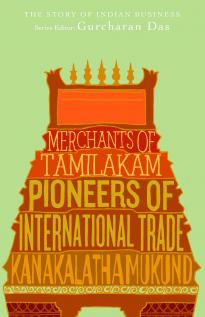Merchants of Tamilakam is the second book in the series ‘The Story of Indian Business’. Talks about the maritime trade in the southern coastal areas of ancient India. The sources for this information lie in the various scriptures of the famous Sangam period in the Tamil region. Primarily poems describing the times and the inscriptions found in the temples talking about donations made by various people and the recorded transactions.
Buy Merchants of Tamilakam at Amazon
The book tells about the trade as it existed from 1st CE to about 1300 CE in the Tamilakam. The name used for defining the land of the Tamils. It talks about the various dynasties that ruled the place during different times. It talks about the items that were traded within the country. And with other countries both with the Arab world in the West and the South East Asian region in the east including Sri Lanka. It talks about the administrative structure that existed to manage and regulate the trade. It talks about port towns, Mahanagarams or big cities, Nagarams or towns, Nadus as a region and urs or villages.
Read More – Arthashastra – The Science of Wealth by Thomas R Trautmann
The taxation included paying all these entities for running different things for society. And the tax rates were not very different from what they are today. It talks about the socio-economic role played by the temples, that acted both as a supplier of capital and consumer of the product in the primarily agrarian society. This is quite interesting as the temples received donations and they used these to plow it back into the society by lending or by acquiring lands where people could work. There were temples in each village and town. And there were temples with royal patronages like the big temple at Tanjore.
Read More – The East India Company by Gurcharan Das, Tirthankar Roy
It talks about the merchant and the merchant guilds that existed. And how they helped the merchants while the merchants were independent to do whatever they wanted. The relationship between merchants and temples is interesting as merchants were the biggest donors to temples. While it is popularly agreed that they did so to gain ‘Punya’ or religious merit, the author argues that they also did this to earn goodwill. As they were the wealthier sections of the society and may have been looked upon as someone indulging in bad practices to earn a profit. So they donated to give the message that their wealth is also being spent on the public good.
Read More – Mumbai’s Dabbawalla by Shobha Bondre
Interestingly, the trade prospered as and when there was political stability. But it did not really go down in unstable times, indicating that it existed pretty independently.
The writing style of this book, compared to the first book is very random. There are lots of repetitions. The same sentences get repeated in the same chapter and across the chapters. It is more academic where the author tries to justify everything that she puts down on paper. Since the sources are the same for most of the book and to a casual reader it is substantiating to know the source but I do not think they need to know what inference came from which inscription.
Read More – The One World School House by Salman Khan
I understand that the purpose of this series is to look at the evolution of Indian business over a long time period. And to bring it to the reader who would not go back to the scriptures to string it all together. I think the book could have been simplified. And a lot more information could have been provided. Similarly, the measures used throughout the book have not been explained. Except at one place where the measures used for land have been explained. They get quite confusing as you get no idea of the quantities being spoken about. I think compared to the first book, editing on this is disappointing. The first book took some concepts and explained it as it is written in Arthahastra followed by an analysis of the same. Here the concepts are not explained, but the translations presented.
Read More – God’s Own Office by James Joseph
Still, I liked the book Merchants of Tamilakam for the content that you may not get to read in easy language. I do not know of any other non-academic book that describes the international trade that used to happen on the coasts of ancient India.
Read Merchants of Tamilakam if the history of business interests you.
The book has been renamed in the current version as The World of the Tamil Merchant: Pioneers of International Trade.









